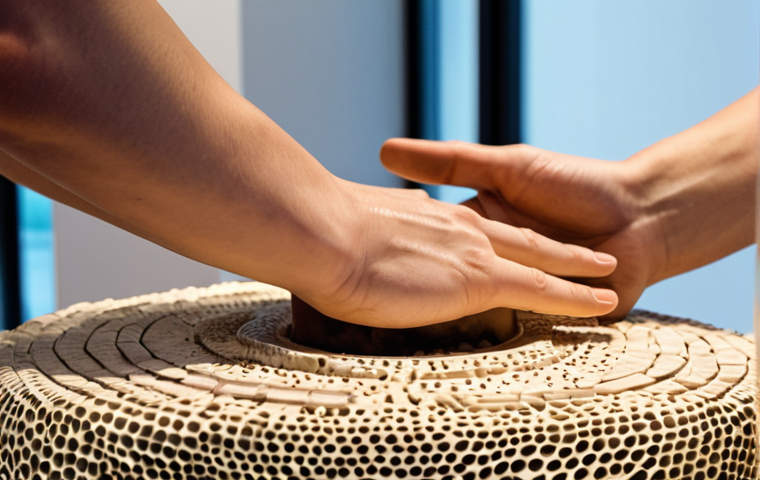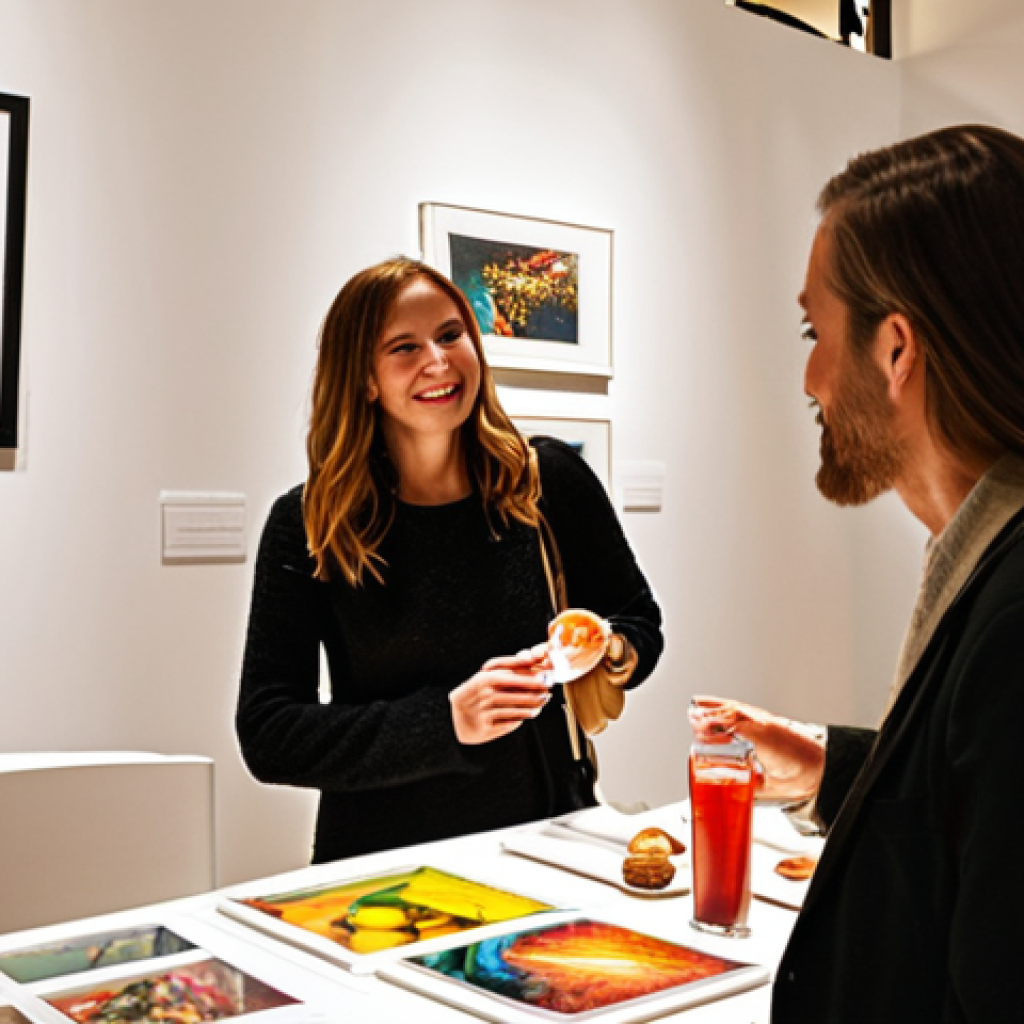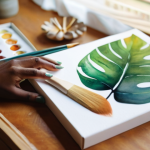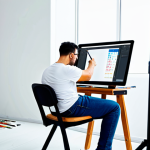Ever wondered how a captivating art exhibition comes to life? It’s more than just hanging paintings on a wall; it’s about weaving a narrative, creating an experience that resonates with visitors long after they’ve left.
From selecting the perfect pieces to designing the space and attracting an audience, the process involves a delicate blend of creativity, organization, and a touch of magic.
Having personally curated a few smaller exhibitions, I can tell you firsthand it’s a rollercoaster of emotions, from the initial excitement of securing the venue to the nail-biting anticipation of opening night.
The key is understanding your audience and creating a journey that intrigues and inspires. Recent trends point towards immersive installations and interactive elements, reflecting a shift towards experiences that actively engage visitors.
Some forward-thinking curators are even incorporating AI and augmented reality to enhance the storytelling aspect of exhibitions, paving the way for entirely new art forms.
Let’s delve into the intricacies of exhibition planning and execution, exploring how to create a truly memorable and impactful show. Let’s find out more in the article below!
Crafting a Theme That Speaks Volumes
Defining Your Exhibition’s Core Message

Choosing Art That Reinforces the Theme
The Subtle Power of Title Selection
Imagine walking into a gallery, not just seeing paintings, but feeling a story unfold with each step. That’s the power of a well-defined theme. It’s not just about pretty pictures; it’s about a cohesive message.
One exhibition I helped curate focused on the theme of “Urban Transformation.” We didn’t just pick random cityscapes; we chose pieces that showed the gritty reality of urban decay juxtaposed with the vibrant energy of renewal.
We even included a graffiti artist who created a live piece during the opening, which was a huge hit! The title of the exhibition was very important. After a lot of discussion, we ended up calling it “Concrete Reveries”.
I think the perfect title should have a slightly poetic feel. Spatial Storytelling: Designing the Visitor Journey
Optimizing Flow for Engagement
Leveraging Light and Sound to Enhance the Mood
Creating Moments of Discovery and Reflection
The layout of an exhibition is an art form in itself. It’s about guiding visitors on a carefully curated journey. Think of it as directing a film, but instead of actors, you have art, and instead of a screen, you have a gallery.
I remember once visiting an exhibition where the flow was so confusing, I ended up feeling frustrated rather than inspired. Don’t let that happen to your visitors.
I think the lighting and sound are also key. A dimly lit room with soft music can create an intimate atmosphere for viewing delicate watercolors, while a brightly lit space with upbeat music can energize viewers encountering bold, abstract sculptures.
For the exhibition that I mentioned earlier, we placed a bench in the center of the gallery. It was a great place to sit, relax, and think about the things you just experienced.
Engaging the Senses: Beyond Visual Art
Incorporating Interactive Elements
Adding Tactile or Auditory Components
The Role of Scents in Shaping Perception
Who says art exhibitions have to be purely visual? Why not engage all the senses? I saw an exhibition recently that included a “scent station” where visitors could smell fragrances that were inspired by the artwork.
It was such a unique and memorable experience! I’ve also seen artists use virtual reality and augmented reality to enhance the experience. It’s all about taking people into another world.
I was planning to include tactile elements in my last exhibition but ran out of time. But next time, I’d love to incorporate tactile components where people can touch and feel some sculptures.
| Sensory Element | Example Implementation | Potential Impact |
|---|---|---|
| Sound | Ambient soundscapes that complement the artwork | Enhances emotional connection, creates atmosphere |
| Touch | Sculptures designed for tactile exploration | Provides a deeper understanding of form and texture |
| Scent | Fragrances that evoke the subject matter of the art | Creates a more immersive and memorable experience |
Marketing and Promotion: Spreading the Word
Crafting a Compelling Narrative
Leveraging Social Media and Digital Marketing
Collaborating with Local Media and Influencers
No matter how amazing your exhibition is, it won’t succeed if no one knows about it. It’s like throwing a party and forgetting to send out the invitations.
One of the biggest mistakes I see is when organizers only rely on traditional methods of marketing. But what about social media? It’s a great way to build excitement and reach a wider audience.
I think it’s also important to build up a relationship with local media. One way to get the media involved is to organize a special media preview and give journalists a sneak peek of the exhibition.
Give them a reason to write about your show! The urban transformation exhibition sold out. It was only a small exhibition, but we managed to attract more than 5000 people.
The Art of the Opening: Creating a Buzz
Setting the Tone with Music and Décor
Providing Refreshments That Complement the Theme
Encouraging Interaction and Networking
The opening night of an exhibition is like a theatrical premiere. It’s the culmination of months of hard work, and it’s your chance to make a lasting impression.
Don’t underestimate the power of atmosphere. Choose music that complements the theme, offer refreshments that add to the experience, and create opportunities for people to mingle and connect.
I have found that providing guided tours helps to initiate interactions and create a sense of community. Managing Logistics: The Devil Is in the Details
Handling Shipping, Installation, and Insurance
Staffing Considerations and Volunteer Coordination
Ensuring Accessibility and Safety for Visitors
Behind every successful exhibition, there’s a mountain of logistical details that need to be managed. From shipping artwork to installing it securely, from handling insurance claims to coordinating volunteers, there’s no shortage of things that can go wrong.
One of the biggest challenges is dealing with customs when shipping artwork internationally. Make sure to get insurance for all artwork. Also make sure that staff is properly trained.
Post-Exhibition Analysis: Learning and Improving
Gathering Feedback from Visitors and Staff
Analyzing Attendance and Sales Data
Documenting the Process for Future Reference
The exhibition is over, but your work isn’t done yet! It’s time to analyze what worked, what didn’t, and how you can improve for next time. Collect feedback from visitors and staff, review attendance and sales data, and document the entire process.
I keep a “lessons learned” journal for every exhibition I curate. It’s a great way to avoid repeating mistakes. Another trick that I use is to send out an online survey to collect feedback from visitors.
Crafting a Theme That Speaks Volumes
Defining Your Exhibition’s Core Message
Imagine walking into a gallery, not just seeing paintings, but feeling a story unfold with each step. That’s the power of a well-defined theme. It’s not just about pretty pictures; it’s about a cohesive message. One exhibition I helped curate focused on the theme of “Urban Transformation.” We didn’t just pick random cityscapes; we chose pieces that showed the gritty reality of urban decay juxtaposed with the vibrant energy of renewal. We even included a graffiti artist who created a live piece during the opening, which was a huge hit! The title of the exhibition was very important. After a lot of discussion, we ended up calling it “Concrete Reveries”. I think the perfect title should have a slightly poetic feel.
Choosing Art That Reinforces the Theme
When selecting art, always ask yourself: “Does this piece enhance or detract from the central theme?” It’s not just about individual beauty but about how each artwork contributes to the overall narrative. Once, I saw an exhibition about “Global Connectivity” that featured a stunning painting of a solitary lighthouse. While the painting was beautiful, it seemed out of place and weakened the overall impact. Try to curate thematically.
The Subtle Power of Title Selection
The title is your first impression. It’s the hook that reels people in. It should be evocative, memorable, and, most importantly, relevant. Avoid generic titles like “Art Exhibition 2024.” Instead, go for something that sparks curiosity. For example, “Echoes of Tomorrow” or “Fragments of Light.” I always brainstorm at least 20 different titles before settling on the perfect one.
Spatial Storytelling: Designing the Visitor Journey
Optimizing Flow for Engagement
The layout of an exhibition is an art form in itself. It’s about guiding visitors on a carefully curated journey. Think of it as directing a film, but instead of actors, you have art, and instead of a screen, you have a gallery. I remember once visiting an exhibition where the flow was so confusing, I ended up feeling frustrated rather than inspired. Don’t let that happen to your visitors. Visitors should navigate the space with ease.
Leveraging Light and Sound to Enhance the Mood
Lighting and sound are key. A dimly lit room with soft music can create an intimate atmosphere for viewing delicate watercolors, while a brightly lit space with upbeat music can energize viewers encountering bold, abstract sculptures. For the exhibition that I mentioned earlier, we placed a bench in the center of the gallery. It was a great place to sit, relax, and think about the things you just experienced.
Creating Moments of Discovery and Reflection
Sprinkle surprises throughout the exhibition. A hidden nook with a thought-provoking quote, an unexpected video installation, or a piece of interactive art. These moments of discovery can leave a lasting impression. Also, ensure you have spaces to sit and reflect. Art can be overwhelming, and visitors need a chance to process what they’ve seen.
Engaging the Senses: Beyond Visual Art
Incorporating Interactive Elements
Who says art exhibitions have to be purely visual? Why not engage all the senses? I saw an exhibition recently that included a “scent station” where visitors could smell fragrances that were inspired by the artwork. It was such a unique and memorable experience! I’ve also seen artists use virtual reality and augmented reality to enhance the experience. It’s all about taking people into another world.
Adding Tactile or Auditory Components
I was planning to include tactile elements in my last exhibition but ran out of time. But next time, I’d love to incorporate tactile components where people can touch and feel some sculptures. Consider incorporating audio descriptions for visually impaired visitors, or adding textured surfaces to sculptures for a tactile experience. These additions can make your exhibition more inclusive and engaging.
The Role of Scents in Shaping Perception
Scents have a powerful ability to evoke emotions and memories. Consider using subtle fragrances that complement the artwork. For instance, a landscape painting could be accompanied by the scent of pine or fresh grass. Just be mindful of allergies and sensitivities. I have also found that having fresh flowers can enhance the overall ambiance of your exhibition.
| Sensory Element | Example Implementation | Potential Impact |
|---|---|---|
| Sound | Ambient soundscapes that complement the artwork | Enhances emotional connection, creates atmosphere |
| Touch | Sculptures designed for tactile exploration | Provides a deeper understanding of form and texture |
| Scent | Fragrances that evoke the subject matter of the art | Creates a more immersive and memorable experience |
Marketing and Promotion: Spreading the Word
Crafting a Compelling Narrative
Your marketing materials should tell a story. Don’t just list the artists and dates; explain the exhibition’s theme, its significance, and what visitors can expect to experience. Use evocative language and compelling visuals. I always try to create a sense of intrigue and excitement. If possible, start marketing early.
Leveraging Social Media and Digital Marketing
No matter how amazing your exhibition is, it won’t succeed if no one knows about it. It’s like throwing a party and forgetting to send out the invitations. One of the biggest mistakes I see is when organizers only rely on traditional methods of marketing. But what about social media? It’s a great way to build excitement and reach a wider audience. Use targeted ads to reach potential visitors, share behind-the-scenes content, and engage with your followers. Use relevant hashtags and collaborate with art bloggers.
Collaborating with Local Media and Influencers
I think it’s also important to build up a relationship with local media. One way to get the media involved is to organize a special media preview and give journalists a sneak peek of the exhibition. Give them a reason to write about your show! The urban transformation exhibition sold out. It was only a small exhibition, but we managed to attract more than 5000 people.
The Art of the Opening: Creating a Buzz
Setting the Tone with Music and Décor
The opening night of an exhibition is like a theatrical premiere. It’s the culmination of months of hard work, and it’s your chance to make a lasting impression. Don’t underestimate the power of atmosphere. Choose music that complements the theme, offer refreshments that add to the experience, and create opportunities for people to mingle and connect. I have found that providing guided tours helps to initiate interactions and create a sense of community.
Providing Refreshments That Complement the Theme
The refreshments should be more than just an afterthought. They should be an integral part of the experience. For a photography exhibition, you could serve drinks in vintage camera lenses or create edible landscapes inspired by the photographs. Get creative and have fun! I always try to use local vendors. It’s a good way to support the community and get a unique experience.
Encouraging Interaction and Networking
The opening night should be a social event. Encourage visitors to interact with each other, the artists, and the curators. Provide conversation starters, organize icebreaker games, or set up a photo booth. The goal is to create a lively and engaging atmosphere where people feel comfortable connecting.
Managing Logistics: The Devil Is in the Details
Handling Shipping, Installation, and Insurance
Behind every successful exhibition, there’s a mountain of logistical details that need to be managed. From shipping artwork to installing it securely, from handling insurance claims to coordinating volunteers, there’s no shortage of things that can go wrong. One of the biggest challenges is dealing with customs when shipping artwork internationally. Make sure to get insurance for all artwork. Also make sure that staff is properly trained.
Staffing Considerations and Volunteer Coordination
Recruit a team of knowledgeable and enthusiastic staff and volunteers. Provide them with adequate training and clear instructions. Assign specific roles and responsibilities. And don’t forget to show your appreciation! A well-organized team can make all the difference in the smooth running of your exhibition.
Ensuring Accessibility and Safety for Visitors
Make sure your exhibition is accessible to everyone, regardless of their physical abilities. Provide ramps, elevators, and accessible restrooms. Offer large-print labels and audio guides. And don’t forget to address safety concerns. Clear any tripping hazards, ensure adequate lighting, and have first-aid supplies on hand.
Post-Exhibition Analysis: Learning and Improving
Gathering Feedback from Visitors and Staff
The exhibition is over, but your work isn’t done yet! It’s time to analyze what worked, what didn’t, and how you can improve for next time. Collect feedback from visitors and staff, review attendance and sales data, and document the entire process. I keep a “lessons learned” journal for every exhibition I curate. It’s a great way to avoid repeating mistakes.
Analyzing Attendance and Sales Data
Crunch the numbers. How many people attended the exhibition? How many artworks were sold? What was the average sale price? This data can provide valuable insights into the success of your exhibition and help you make informed decisions for future events. You can also track what times and days you have the most traffic to help inform future scheduling.
Documenting the Process for Future Reference
Another trick that I use is to send out an online survey to collect feedback from visitors. Create a detailed record of the entire exhibition process, from planning to execution to post-exhibition analysis. Include photographs, floor plans, marketing materials, and any other relevant documents. This archive will be a valuable resource for future exhibitions.
In Conclusion
Crafting an unforgettable art exhibition is about more than just hanging paintings on a wall. It’s about creating an immersive, engaging, and thought-provoking experience for your visitors. By paying attention to the theme, the flow, the senses, and the logistics, you can create an exhibition that leaves a lasting impression.
Useful Tips to Know
1. Always have a backup plan for everything. Murphy’s Law is a real thing in the art world.
2. Network with other artists and curators. The art world is all about connections.
3. Be prepared to adapt. Things rarely go according to plan, so be flexible and willing to adjust your approach.
4. Don’t be afraid to take risks. Sometimes the most unconventional ideas are the most successful.
5. Stay true to your vision. Don’t let others sway you from your artistic goals.
Key Takeaways
– Theme is paramount: Define a clear, compelling theme to guide your selection of art and overall design.
– Sensory engagement matters: Go beyond visual art by incorporating interactive elements, tactile components, and evocative scents.
– Logistics are crucial: Meticulous planning and coordination are essential for a smooth and successful exhibition.
– Promotion is key: Develop a comprehensive marketing strategy that leverages social media, local media, and influencers.
– Post-exhibition analysis is vital: Gather feedback, analyze data, and document the process to learn and improve for future exhibitions.
Frequently Asked Questions (FAQ) 📖
Q: What are some key considerations when selecting art pieces for an exhibition to ensure they resonate with the audience?
A: From my experience, understanding your audience is paramount. Think about what kind of art they typically engage with, what themes might resonate with them, and what kind of emotional experience you want them to have.
It’s also vital to consider the overall narrative you’re trying to create. Do the pieces work together to tell a story? Do they complement or contrast each other in a way that’s interesting and thought-provoking?
Personally, I’ve found that pieces that evoke strong emotions or challenge viewers’ perspectives tend to leave a lasting impression.
Q: The article mentions incorporating
A: I and augmented reality into exhibitions. Can you provide some specific examples of how these technologies are being used in practice? A2: Absolutely!
I’ve seen some really innovative uses of AI and AR lately. For example, some exhibitions are using AI to generate interactive artworks that respond to the viewer’s movements or emotions.
Others are using AR to overlay digital information onto physical artworks, providing additional context, historical background, or even hidden layers of meaning.
Imagine pointing your phone at a painting and seeing it come to life with animations or hearing the artist’s voice explaining their process. It’s pretty mind-blowing and definitely enhances the engagement factor.
Q: What are some common challenges faced during the exhibition planning and execution process, and how can they be effectively addressed?
A: Oh, where do I even begin? Budget constraints are always a huge hurdle, as is securing the perfect venue. Then there’s the logistical nightmare of transporting and installing the artwork safely and on time.
Marketing and promotion are also critical, and it’s easy to get lost in the noise. From my own experiences, it’s essential to have a detailed plan with contingencies for everything.
Build strong relationships with artists, vendors, and sponsors. And don’t be afraid to ask for help. Having a reliable team is crucial for navigating the inevitable bumps along the road.
And most importantly, stay calm and remember why you’re doing it in the first place – to share the beauty and power of art with the world.
📚 References
Wikipedia Encyclopedia






